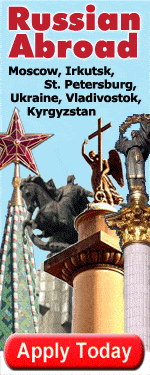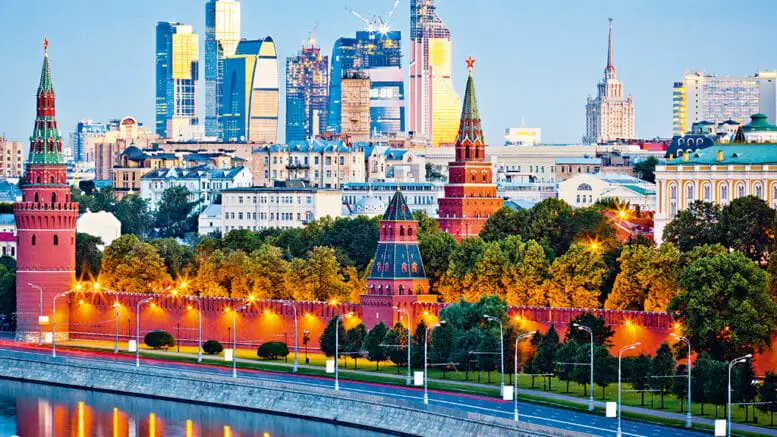
The Russian White House, home to The Federation Council (Russia’s senate) as seen from a subway car window printed with the words “Do Not Press (Lean) Against.” Photo by Garrett Pappas.
Moscow’s official population of 10.5 million makes it the world’s seventh most populous city. In addition, the city also contains nearly two million official “guests,” registered foreigners mostly from the former Soviet Republics, many of whom have lived in the capital for years. Moscow also has a massive unregistered population of illegal immigrants – Russia’s Federal Migration Service estimates that these inhabitants add about another million to Moscow’s effective population.
Within Moscow’s borders on any given day are also a few million commuters who live in the city’s sprawling suburbs but work or shop in the city itself. Adding still more people who arrive there as tourists, on business, or other reasons, and the actual population of Russia’s capital rises to 17-20 million people, as estimated by Moscow’s Metro System and Russia’s Interior Ministry.
In short, Moscow is a city layered in complexity and mass that can be surprising and even shocking at times. History has created stark contrasts there between the rich and the poor, the socialists and capitalists, the young and old, and between the Czarist, Soviet, and modern influences which all visibly compete for space in Moscow’s changing skyline.
Pre-Revolutionary Moscow
The name Moscow was first recorded in 1147 when Yuri Dolgoruki formally invited his allies to what was at the time probably a small fishing village. He said: “Come to me, brother, please come to Moscow.” Ten years later a wooden wall was constructed to protect the new military outpost. That wall was rebuilt several times to accommodate expansion, helping to form the future capital’s distinctive dense and spider-web-like pattern of development.

Click on the students in front of Moscow’s Christ the Savior Cathedral for your study study abroad options in Moscow!
Moscow was mostly destroyed in the Mongol invasion of 1237, but was rebuilt and later became a regional capital under the rule of its captors. Via political savvy during the occupation and military might during the rebellion, Moscow became the political center of Russia as the Mongols were driven out.
Yet this did not mean that Moscow’s troubles had ended. It was burned again by the Tatars in 1537, suffered rebellions and riots throughout the 1600s, was conquered briefly by the Poles and Lithuanians, ravaged by plague in the 16th and 17th centuries, and burned by its own inhabitants in an attempt to thwart the advancing Grand Army of Napoleon in 1812.
Moscow also, of course, lost its place as the Russian capital in 1712 as Peter the Great built a new capital, St. Petersburg, from scratch. The Communists named Moscow the capital of the USSR in 1922, less than two decades before the Battle of Moscow would see Nazi tanks arrive at the city outskirts and Nazi bombs drive many Muscovites to seek shelter in the still-expanding Metro subway system.
Soviet Development

Stalin’s monumental efforts to modernize Soviet Russia focused heavily on supplying Moscow with new buildings and wide boulevards, albeit often at great expense – tearing down entire historic districts, razing churches and other architectural monuments, and using poorly-treated prison labor.
Moscow also saw its number of educational institutions soar with numerous schools built and Moscow State University ambitiously expanded with a new campus and what would become its iconic main building.
Under the political and economic stagnation that marked the Brezhnev era and beyond, the capital’s store shelves emptied, and occasional protests occurred. As the political situation neared critical, Gorbachev attempted to rebuild the economy and establish a new political structure for the USSR that would keep Moscow at its center.

The Moskva City development project rises above Soviet-built housing and factories. Photo by Garrett Pappas.
This was not to be, however. In August 1991, tanks rolled through the city streets. Members of the Communist elite and the KGB staged an ill-conceived coup to stop the democratic reforms. This quickly led to massive counter protests in which Boris Yeltsin gained much political capital by opposing the coup and supporting reforms. He would later engineer the breakup of the USSR and become the first president of an independent Russia.
Post-Soviet Moscow
Moscow today offers a broad mix of contemporary and gilded architecture. Iconic structures like the onion domes of Saint Basils Cathedral and the towers of Stalin’s Seven Sisters still remain the focal point of Moscow, joined by the new, postmodern sky scrapers of the “Moskva City” development. Many churches, such as the massive Christ the Savior have been rebuilt following their Soviet demolition.
However, with the arrival of a market economy, construction and real estate costs have skyrocketed to become some of the highest in Europe. In part because of this, many buildings treasured by locals such as, most recently, the tsarist-era Deacon’s House, which was recently raised to make way for apartments and offices and the soviet-era Melnikov House, which is currently the center of a property dispute. Plans to build a commercial center underneath Pushkin Square saw protests that the “heart of the city” would be destroyed in the name of shopping.
However, not all development projects have proved counter-productive. The Red October Chocolate Factory, for instance, in the center of Moscow, has moved from being an under-used industrial structure to a growing shopping, education, and cultural center that has retained the building’s historical structure and façade. Winzavod is another success story, having turned an abandoned wine factory into retail, office, recreation, and exhibition space that is wildly popular with Moscow’s young and creative.

Another of Moscow’s unique museums is the Museon, an outdoor sculpture park sometimes called “the statue graveyard” as it contains many statues pulled down and vandalized as the Soviet era ended. Picture from Moscow-photos.com
Winzavod is one of many new galleries in the Russian capital, joining others such as The Garage and The Ekaterina Art Fund. All three are privately funded and organized by liberal curators, and have been instrumental in changing the artistic landscape in Moscow by supporting avant garde and untraditional art mediums.
Moscow’s most ambitious construction project is currently Moskva City, which has cleared a former industrial zone in favor of post-modern residential and commercial skyscrapers. With a price tag of some $12 billion, the project was conceived as a new business hub that would turn Moscow into a world financial center by marketing office space to banks. However, the current economic downturn has drastically modified plans or even halted construction on many buildings. Most notably, Russia Tower – once slated to become Europe’s tallest building – has been cancelled and replaced with a multi-story parking garage.
Moscow is still no stranger to dramatic political events. Yuri Luzhkov, who had headed Moscow’s government since the 1990s was removed from office by President Medvedev using a 2006 law that allows the president to appoint and fire governors and the mayors of Moscow and St. Petersburg. Medvedev never gave specific reasons for his “loss of confidence” in the long-serving mayor, but he did, when appointing Sergei Sobyanin as the new mayor, give him specific tasks: bring down corruption, improve traffic, and maintain the city’s extensive social programs.
Moscow is still Russia’s economic as well as political capital. The GDP of Moscow accounts for nearly a quarter of Russia’s entire economy and the capital has budgetary expenditures of more than 40 billion dollars in addition to the many federally-funded projects underway there. This has allowed the city to launch what are commonly known as “Luzhkov Benefits,” special pension, maternity, and other welfare programs secured by the former mayor that Sobyanin is now charged with maintaining.
However, the development of business in the capital is held back not only by high real estate costs but also by corruption and infrastructure problems.
In one of well-publicized corruption story, IKEA, a long-time investor in Russia, sacked two local executives for condoning bribery connected to construction inspections and trying to connect to the government-run electrical grid.
Public works projects have also been widely affected by corruption. The Bolshoi Theatre, closed in 2005 for restoration, but has seen numerous delays in part because of revelations that many of the millions of dollars spent on the project have gone to corruption, double-billing schemes, or simply disappeared. This has additionally cast doubt over the Pushkin Museum of Fine Art’s slated one-billion-dollar reconstruction that will expand the gallery space (it is already the largest in Russia) and connect all buildings via tunnels.

The Moscow River flowing past the Kremlin at dusk. Photo by Garrett Pappas
Traffic is also affected by corruption, as Moscow has long (in)famously preferred high-profile and high-budget projects to fix its problems rather than investing in simpler and less expensive projects like more interchanges and better-coordinated traffic lights. Thanks in part to a medieval center and a heritage left from Soviet planners who never anticipated wide-spread car ownership, traffic is now so bad that Moscow’s generally politically apathetic populace will unite behind the issue in large and diverse protests.
Having already survived revolutions, plagues, invasions, and dictatorship, Moscow will always be resilient. Muscovites have entered the 21st century with a new confidence embracing a modern age and demanding a new level of respect. Traveling more than ever and flaunting their new wealth, Muscovites today are eagerly awaiting the opportunities promised by the New Russia. They are breaking down the barriers that plagued past generations and searching for meaning in the new possibilities of consumerism, creativity, and capitalist careers.



